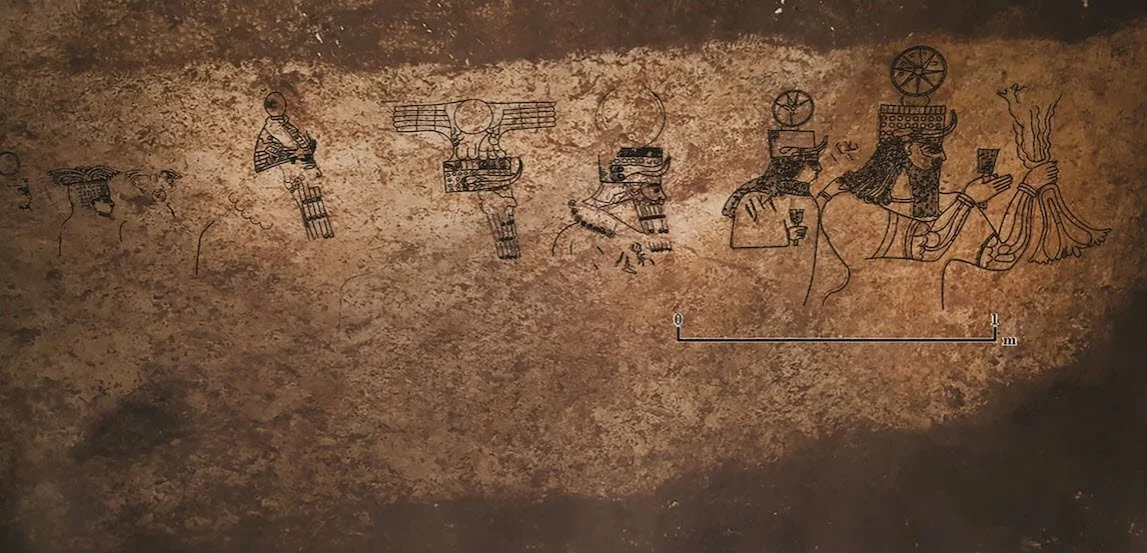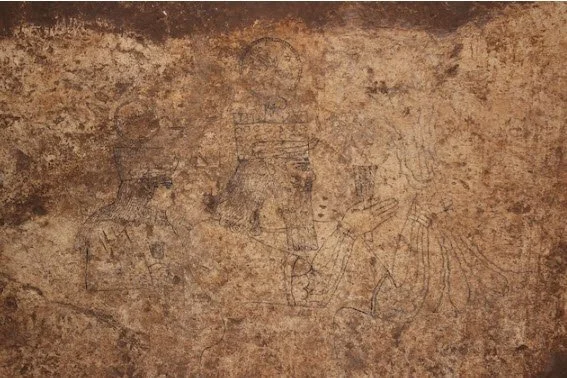3000 Year Old Rock Carving in Turkey - Fall 2022
he ghostly profiles of ancient gods emerge from a ca. 3,000-year-old rock carving in Turkey. Police tracked looters to the subterranean complex, likely built during a time when the Assyrian Empire was expanding in the region in the 8th century B.C.
Secret tunnel reveals procession of ancient gods
Assyrian deities of thunder and the moon were revealed by archaeologists in an underground chamber originally discovered by looters.
a drawing carved into stone showing a procession of gods with a drawing over it to accentuate the carvings
The divine procession ls led by Hadad, Mesopotamian god of storms (far right, clutching a trio of lightning bolts); the moon god Sîn; the sun god Šamaš; and Atargatis, the region’s goddess of fertility, all identified using local Aramaic inscriptions.
Archaeologists have discovered rare ancient carvings of Assyrian gods in an underground complex in southeastern Turkey—an unprecedented find that may point to the use of “soft politics” in a frontier region of the world’s most powerful empire almost 3,000 years ago.
The carved scene depicts at least six gods, including Hadad, the Mesopotamian god of storms; the moon god Sîn; the sun god Šamaš; and Atargatis, the region’s goddess of fertility. It is described in an article published today in the journal Antiquity.
The nature of the discovery is also unusual: police found the subterranean complex in 2017, after following a secret passage to it from a modern two-story house in the village of Başbük, about 30 miles from the city of Şanlıurfa.
Article co-author and philologist Selim Ferruh Adalı of the Social Sciences University of Ankara says it seems the complex was first unearthed when the house was being built several years earlier. But the discovery wasn’t reported to authorities, as Turkey’s law requires; instead, looters crafted a tunnel from the house to the underground passages. The looters were eventually caught, and they do not appear to have damaged the carvings.
Mehmet Önal, the article’s lead author and head of archaeology at Harran University in Şanlıurfa, first saw the underground carvings by the flickering light of a lamp.
“I felt as if I was in a ritual,” he recalls. “When I was confronted by the very expressive eyes and majestic, serious face of the storm god Hadad, I felt a slight tremor in my body.”
Imperial style, local symbolism
The subterranean complex consists of hundreds of feet of passages, staircases, and galleries hewn from the bedrock. Both the complex and the carvings seem unfinished, and the researchers speculate construction unexpectedly stopped, likely early in the 8th century B.C.
An inscription beside the carvings shows a partial name, which the researchers think reads “Mukīn-abūa.” He may have been the Mukīn-abūa listed in Assyrian records around 2,700 years ago as governor of the provincial capital of Tušhan, about 90 miles to the east of modern Başbük.
If the reading is correct, Adalı suggests, it could be that Mukīn-abūa had ordered the subterranean complex built and the carvings made, only to have work cease when he was no longer governor.
The ancient gods are depicted in procession across a 12-foot-wide panel of rock wall. Six faces can be seen, and four of the gods are identifiable—the storm god Hadad, for example, is carrying a trio of thunderbolts. Each delicately carved portrait, the largest of which is over three feet in height, shows the head and upper body of a god with lines of the image highlighted in black paint, possibly as a guide as the artists cut more stone away to show the figures in relief.
Adalı notes that although some features of the gods are distinctly Assyrian—such as their rigid poses, and the particular style of their hair and beards—many details of the carvings show strong influences from the local Aramaic culture. Arameans had lived in the region for centuries before they fell under the rule of the rapidly expanding Assyrian Empire in the ninth century, coming under the control of kings who lived far to the east in northern Mesopotamia.
Adalı also notes that the inscriptions beside the carvings are written in Aramaic and give the Aramaic names of the gods, rather than their Assyrian names. “It’s primarily Aramaic symbolism that we find, melded with Assyrian style,” he says, adding that the deliberate mix may have been an attempt by the distant Assyrian rulers to integrate with local leaders, rather than rule by force.
Archaeologist Davide Nadali of Rome’s Sapienza University agrees that the unique artistic mix of Assyrian and Aramaic features in the carvings sheds interesting political light on the relationship between the powerful empire and one of its key territories.
“The inscriptions in Aramaic emphasize the intention to have a dialogue with local communities, [while] the use of Assyrian figurative style shows the need to interact with the Assyrian political power,” he says in an email.
https://www.nationalgeographic.com/history/article/secret-tunnel-reveals-procession-of-ancient-gods?rid=4C44F2CB62065CD56A884C3E4B615AA8&cmpid=org=ngp::mc=crm-email::src=ngp::cmp=editorial::add=SpecialEdition_Escape_20220921


